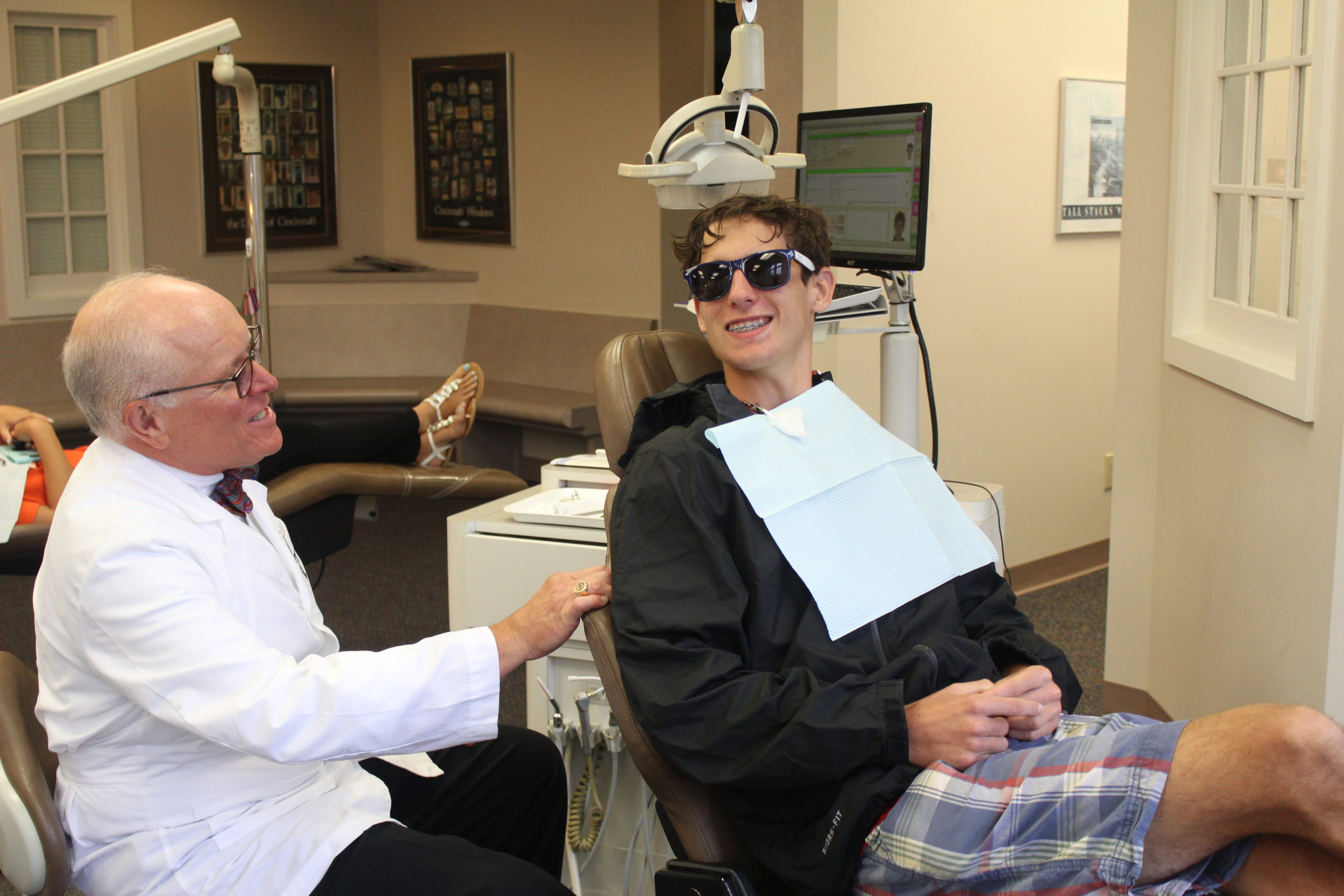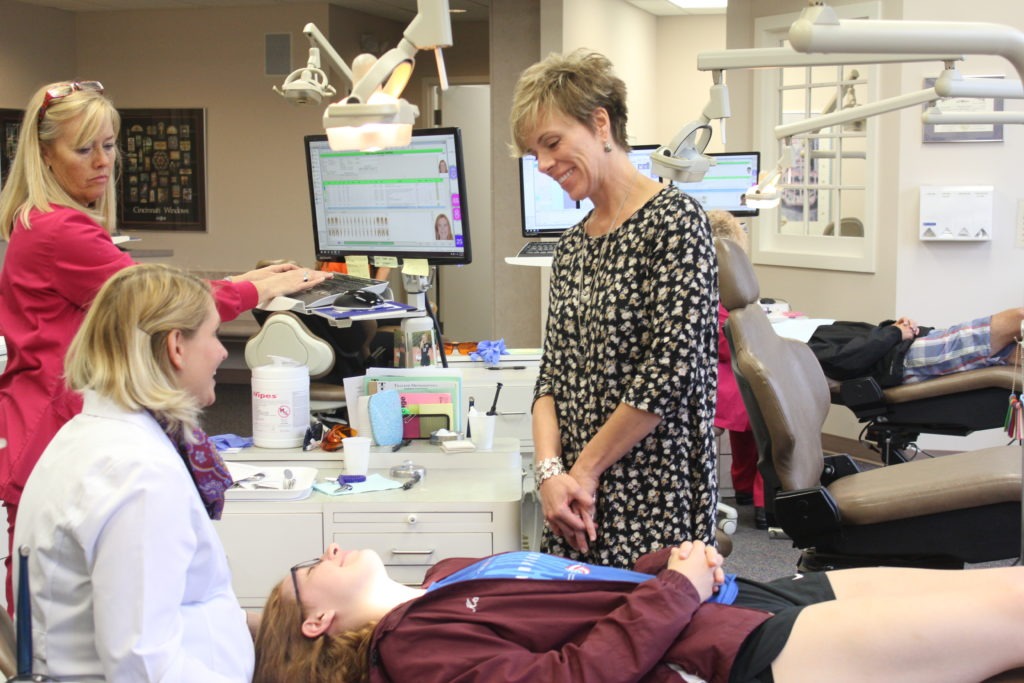Undergoing orthodontic treatment with braces has many benefits, the most obvious of which is a beautifully aligned, fully functional smile! However, like most things in life, it can come with its own set of challenges. One of these learning curves can be finding and maintaining an effective dental hygiene routine. Brushing and flossing regularly is essential for good oral health, but when you’re wearing traditional metal braces, you may find it’s a little tricky to navigate around the brackets, wires, and bands to get your teeth and gums really clean. Flossing properly can also be a little frustrating, especially in the early days. But if you don’t successfully remove the plaque from your teeth daily, it can build up into a sticky, invisible film that produces bacteria. In turn, this bacteria may lead to gingivitis, a minor gum disease that is surprisingly common.
Anyone can develop gingivitis, not just those wearing braces. Although it can sometimes accompany orthodontic treatment, it’s reversible so there’s no need to wait until you’re finished with treatment to get rid of it. Here at Thacker Orthodontics, we want to provide you with a smooth, stress-free orthodontic experience, and that means supporting your dental health as well as correcting any orthodontic issues. Let’s look a little more closely at what exactly gingivitis is, why you’re more prone to it when you’re in braces, and what we can do to help you avoid it!
It all comes down to plaque
When you bite down into a snack or your supper, braces can push stray food particles into the brackets. While most of this debris will rinse out easily, some of it can get caught in the tiny spaces between your gums, teeth, and brackets. When food gets trapped in these nooks and crannies, it can be very difficult to clean them out effectively. Bacteria live and breed in plaque, so any time you get pockets of it like this near the gums, it can cause gingivitis. The resulting inflammation and swelling is essentially a reaction by your immune system to keep bacteria at bay.
Orthodontics themselves are a form of what we refer to as controlled inflammation. This helps the gums to become more relaxed, and as a result, braces are better able to guide the teeth into new and improved positions. But because your gums are already inflamed and under stress when you’re in braces, it doesn’t take much for bacteria to irritate them even further, causing the aforementioned immune reaction. Some of the symptoms that can accompany this include:
- red, irritated, or swollen gums
- minor bleeding after brushing and flossing
- tenderness in the gums
- noticeably bad breath
- loose teeth
If gingivitis is not addressed and treated, a more severe form of gum disease called periodontitis can develop. Without treatment, the body will attempt to fight off the byproducts of bacteria naturally by breaking down the bone and connective tissues that hold the teeth in place, causing the gums to begin receding and forming pockets in between the teeth. This can lead to possible bleeding, pain, and serious damage over time.
Keeping gingivitis away while wearing braces
As you can see, it’s quite easy for inflammation to get out of hand while undergoing orthodontic treatment with braces, especially if you aren’t vigilant about your dental hygiene routine! Although brushing and flossing daily is usually enough to keep gingivitis at bay, braces can make brushing more difficult, and flossing can be time-consuming. Fortunately, there are a number of products available that are designed to help orthodontic patients keep their teeth clean and healthy!
One example of this is interdental brushes. These are thin, round, or cone-shaped brushes with a small head of bristles that are held on by wire. Some have short or specially shaped handles that make them easier to grip, while others have long handles that are similar to toothbrushes. Studies have shown that using an interdental brush is one of the best ways for braces patients to remove plaque because they’re designed to be inserted between the teeth, reaching right into the tight spaces where plaque is likely to build up. They come in several different sizes, so you’re almost guaranteed to find one that fits comfortably between your teeth without you having to put any force behind it.
When added to a regular regimen of brushing and flossing, certain mouthwashes can also be an effective form of preventative dental care thanks to its ability to kill bacteria. Look for the following in order to help prevent and combat gingivitis.
Breath fresheners
Some mouthwashes mask or eliminate unpleasant breath odors by using antibacterial ingredients, so they can be useful in preventing gingivitis as well. Do pay attention to their ingredients, however, as a growing number of new mouthwashes that focus on freshening breath have chlorine dioxide as their primary ingredient. While this can be effective at neutralizing the kind of bacteria that cause bad breath, it won’t do much about the bacteria that cause plaque and gingivitis.
Antibacterial rinses
Antibacterial ingredients can be found in many over-the-counter types of mouthwash and rinses. These products will also often contain essential oils that can kill plaque-causing bacteria, such as thymol, eucalyptol, methyl salicylate, and menthol. When you combine these ingredients with proper brushing and flossing, it can be helpful in preventing gum disease.
Keep your teeth and gums healthy while we straighten your smile
Here at Thacker Orthodontics, we know the dedication it takes on your part to complete orthodontic treatment successfully. Dr. Jim, Dr. MaryEvan, and the rest of our talented team want to give you the best chance at a healthy mouth and beautiful smile! By following our advice and remaining diligent about your oral hygiene, you should be able to spot any potential signs of gingivitis before it gets out of hand.
Early action is the best course of action next to be preventative care, so don’t hesitate to contact us if there’s anything concerning you. And don’t be tempted to cut corners with your oral hygiene routine, either, because regular brushing and flossing is still the best way to prevent plaque from breeding bacteria in your mouth. It might be a bit more challenging to keep your teeth and gums clean and free of plaque and bacteria when you’re wearing braces, but it’s worth the extra effort!
If you’ve experienced any potential symptoms of gingivitis, or have any questions or concerns about your treatment, don’t hesitate to get in touch with our Cincinnati or Hillsboro office. We’re dedicated to providing you with the best orthodontic experience possible, and we are happy to do whatever we can to keep your smile on track!


